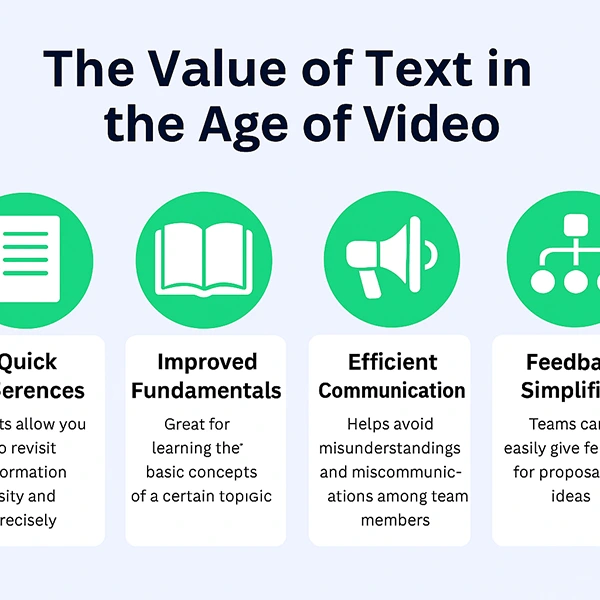AI transcription increases accessibility, saves time, enhances searchability, and allows videos to reach greater, more diverse audiences.
KEY TAKEAWAYS
- AI video transcription improves accessibility for diverse audiences and situations.
- Text transcripts save time by making video content searchable and scannable.
- Transparency increases when spoken words are available in written form.
- AI tools enable fast, accurate transcription and automatic content summaries.

A Wyzowl survey in 2023 revealed that 91% of people want more brands to produce video content, and within that 50% prefer captioned video or transcripts for additional understanding. This shows the growing need for accessible video experiences.
I think using video to text can provide access to video content to new audiences, and potential customers, especially, though not limited to people who are deaf and hard of hearing and visual processors.
In this post, we will look at how AI tools will convert video to text, why that’s a game-changer for accessibility and efficiency, and how to leverage AI to enhance audience engagement.
Watching a video can be engaging, but it isn’t always the most practical way to absorb information. Text, on the other hand, offers quick scanning, direct quotation, and easy archiving. When you add AI transcription to your workflow, you enjoy the best of both worlds: the rich, visual experience of video and the efficiency of searchable, editable text.
Think about it: if you need to pull one quote from a 45‑minute presentation, scrubbing back and forth is slow. A transcript lets you jump right to the line you need. That alone saves a chunk of time, but the benefits go even deeper. Below, you can see some other reason why text matters.

A major advantage of converting video into text is the enhanced accessibility it offers to a wider, more diverse audience. Captions and transcripts help people who are deaf or hard of hearing, but they also serve non‑native speakers, noisy work environments, and anyone who prefers reading over listening.
When you’re converting from video to text, you need to make sure you’re using an excellent platform, such as HappyScribe’s video to transcript tool, which is one of the most widely downloaded transcription tools.
Here’s how AI transcription supports a broad audience:
By addressing diverse needs, you expand your reach and avoid alienating segments of your audience. It’s not just a moral win; it’s a practical one that increases engagement.
Across industries like journalism, research, politics, and business, transparency isn’t optional—it’s a fundamental necessity for credibility and accountability. Providing a text version of spoken words gives stakeholders, regulators, and the public a clear record that can be audited and referenced later.
A text transcript:
Seeing the exact words in text form helps reduce doubt and builds trust. Transparency fosters confidence that the message hasn’t been manipulated.
Manual transcription is tedious and expensive. AI tools now process speech in real time or near‑real time, delivering transcripts within minutes rather than hours. That rapid turnaround transforms the way you create, analyze, and share content.
Editing video often starts with marking the script. When you already have a transcript, you can:
Editors no longer sit through the entire clip repeatedly. They jump straight to the pieces they need. Also, AI systems can go beyond simply transcribing. They’re also capable of identifying main ideas, recognizing speakers, and detecting emotional tone. Imagine finishing a virtual meeting and receiving an automatic summary of action items in your inbox. That’s real‑world efficiency gained.
Once your video is text‑based, indexing becomes simple. You can build a searchable library, where typing one phrase surfaces all the appropriate clips. That’s invaluable for marketers reusing content, educators gathering lecture material, and legal teams building case files.
To leverage these benefits fully, you require a clear process. AI isn’t perfect out of the box, but it’s surprisingly accurate with the right setup.
You need to pick clear microphones, minimal background noise, and consistent speaker volumes to help AI recognize words correctly. A tidy audio setup may seem minor, but it significantly improves transcription accuracy.
If your videos cover technical topics, medicine, engineering, or finance, feed specific glossaries into the AI model when possible. Custom vocabularies improve recognition of industry jargon, product names, and unique acronyms.
Did you know that even a 95 percent accurate transcript leaves errors? A quick human pass to fix names, numbers, and specialty terms ensures total precision. The AI does the heavy lifting, you polish the final output.
You should also consider automating your workflow, allowing each new video to automatically initiate a transcription process. Store text alongside the original file and make it accessible to the teams that need it, whether that’s marketing, compliance, customer support, or research.
Transcription isn’t only for media companies. Nearly every sector gains efficiency by unlocking text from video.
AI isn’t stopping at turning video into plain text. Expect deeper analytics that interpret context, tone, and even body language cues.
These advances build on the foundation of reliable text conversion. By adopting AI transcription now, you prepare for more sophisticated features tomorrow.
Making video‑to‑text conversion part of your routine doesn’t have to be a massive project. Start simple:
Bit by bit, you’ll see how time savings and improved accessibility compound.
Video should be transcribed to text using AI tools, not simply a choice. There are so many neat tools out there today that can accomplish text transcription for your video content, so why not include the text that goes with it?
This makes your content available to an even broader audience. It gives people who may be entirely different from you the chance to consume your content. It also allows you to take that text and possibly transcribe it to other languages, which ultimately gives you an even broader audience that may not have initially engaged with your video.
This should be a simple task with an enormous result, and ultimately improve accessibility and reach. Ultimately, everybody wins.
AI transcription increases accessibility, saves time, enhances searchability, and allows videos to reach greater, more diverse audiences.
If you have quality audio and create custom vocabularies, AI tools can provide as much as 95% accuracy, and save you a lot of time editing.
AI transcription tools benefit education, corporate training, customer support, research, and media, especially for efficiency and accessibility.
